|
|

This chapter describes how to use call types to categorize incoming calls. It includes:
Before ICM software executes a routing script, it classifies each call into a call type that you have defined. ICM software then determines the script to execute based on the call type schedule.
A call type is described in terms of three call qualifiers:
Each call type is associated with one or more dialed numbers. For each dialed number, you can limit the call type to only those calls with specific CLID values and with specific CEDs.
 |
Note Using call types to categorize incoming calls is just one segmentation method the Script Editor provide. For information on further refining call categorization, see "Segmentation" and "Target Selection". |
Figure 2-1 shows how ICM software might determine the call type of calls to a specific dialed number. After classifying the call by dialed number (DN), ICM software then further classifies it by CLID, and then by CED.

You can further refine call types by combining CLID and CED qualifiers. For example, you could have separate call types called Massachusetts_Sales, Massachusetts_Support, etc.
As shown in Figure 2-2, to set up call types you need to do some work in the Configuration Manager and some work in the Script Editor. Use the Configuration Manager to create dialed numbers, call types, and regions. Use the Script Editor to create the mappings among call qualifier values and specific call types.
 |
Note For added information about creating dialed numbers, call types, and regions, see the Configuration Manager online help. |
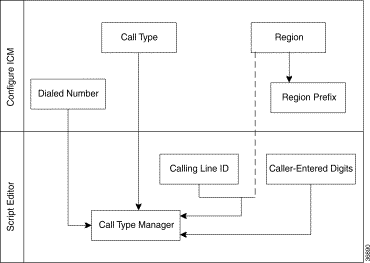
Within the Script Editor, you associate call types with specific combinations of DNs, CLIDs, and CEDs through the Script Editor's Call Type Manager dialog box.
The following sections describe how to define your call types and how to set up the associations between call types and specific call qualifiers.
 |
Note For information on configuring dialed numbers, see the Cisco ICM Software Configuration Guide. |
Typically, every dialed number is associated with one or more call types. Use CLID and CED values to refine the call segmentation.
The calling line ID (CLID) is the caller's billing telephone number: the telephone number of the phone from which a call originates. The CLID is sometimes referred to as the ANI (for Automatic Number Identification).
By default, ICM software compares the list of values against the calling line ID of the call. In practice, however, you're more likely to define a call type that applies to one or more entire area codes or local exchanges.
Use a CLID prefix to specify the leading digits of a telephone number (such as an area code or an area code and local exchange code).
For example, you might want to define a call type for all calls from the 508 area code. In that case, specify 508 as the CLID prefix. If you want to limit the call type to only calls from the 486 exchange within the 508 area code, specify 508486 as the CLID prefix.
Using a CLID prefix in a call type association limits you to a single prefix. Regions provide a way to associate a call type with more than one prefix.
 |
Note A set of geographical regions for different countries, states, etc. are predefined during ICM installation. You can also create custom regions. For more information, see the Configuration Manager's online help. |
Caller-entered digits (CEDs) are values entered by a caller in response to prompts. For example, the caller can be prompted to enter a digit to indicate the type of service desired. The caller can also be prompted for an account number or other identifier.
The prompt might occur in the long distance carrier network or at a call center to which the call is routed. Regardless of where the prompt occurs, you can use this information to classify the call.
You can differentiate between the case where the caller is not prompted for digits (that is, None Required) and the case where the caller is prompted, but enters nothing (None Entered). If you choose None, you can choose to apply the call type for either or both of these cases.
Step 2 Click Retrieve to enable the add button. Then click Add.
Step 3 In the Attributes tab, enter the following:
Step 4 If the Security tab is enabled, click it and enter the access rights you want associated with this call type. See the online help if you have questions.
Step 5 When finished, click Save.
Step 6 Click Close to close the Call Type List tool.
Before you use the call type you've defined, you must associate it with a specific dialed number and with the CLID and CED values that you want.
 |
Note The following procedure shows how to use the Configuration Manager to associate a dialed number with a call type. You can also use the Script Editor's Call Type Manager to do the same thing. |
Step 2 Click the Call Type Mapping tab, choose the dialed number from the drop-down list, and click the Add button. The Add Dialed Number Entry dialog box appears.
Step 3 Enter values for the following:
Step 4 Click OK to return to the Call Type Mapping tab. The Script Editor inserts the new value at the end of the list. To sort the list from the most specific to the most general, click Sort. To customize the list order, use the Up and Down buttons.
 |
Note ICM software does not save the new call type association until you click OK in the Call Type Manager. |
If the specific call qualifiers of a route request do not map to a call type, ICM software can use a default call type. You can define a default call type for each routing client. You can also define a general default call type.
When ICM software receives a route request it tries to map it to a call type, as follows:
1. If the call qualifiers map to a specific call type, it uses that call type.
2. If no specific mapping has been defined, it uses the default call type for the routing client.
3. If no default call type is associated with the routing client, it uses the general default call type.
4. If no general default call type has been defined, it uses the default label defined for the dialed number.
5. If no default label is defined for the dialed number, it returns an error to the routing client.
Use the Configuration Manager to set up general and specific default call types.
Step 2 In the Select filter data box, select the filters you want and click Retrieve. The retrieved NICs or PGs appear in the tree list box.
Step 3 In the NIC Explorer, expand the tree list to display the routing client you want and then select the routing client. In the PG Explorer, expand the tree list to display the peripheral you want and then select the peripheral.
Step 4 In the Routing Client tab, select a value from the Default call type field's selection list. The list contains all call types that have been defined in the system.
Step 5 Click the Save to save the change in the database and then click Close to close the configuration window.
The default call type is used for any call from the routing client that does not map to another call type. You can also define a general default call type. The general default is used as the default call type for any routing client that does not have a specific default call type.
Step 2 Choose a value from the Default Call Type field's drop-down list.
Step 3 Click Save to save your changes and Close to close the window.
A region is a collection of calling line ID prefixes. A simple region has one or more member prefixes. For example, ICM software might predefine a region for each state in a country. Each of these contains one or more prefixes (or area codes).
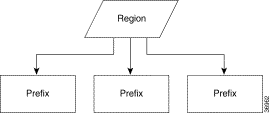
For convenience, you can make one region a member of a larger region. The sub-region's prefixes are effectively added to the parent region. For example, you might define a region that contains the southeastern states.
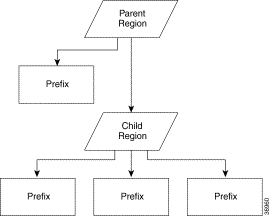
A parent region may contain one or more child regions plus one or more additional prefixes. A parent region may also be a child region of a still greater region. In this way, you can create many layers of nested regions.
A view is a collection of regions that encompass the entire call-origination territory without overlapping each other. A view is sometimes called a map. ICM software predefines a simple template view. You can define additional custom views.
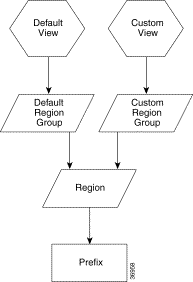
Several special rules apply to views and their regions:
If you define your own custom views, you can create your own region groups.
The Configuration Manager provides two tools for managing regions:
Use the Region Explorer to manage region views. The Region Explorer lets you view, and (if you have maintenance privileges) create, delete, or modify custom region views.
In the Region Explorer:
In summary, in the Region Explorer, you cannot create new regions, though can create different groups of regions. The number of default regions is always the same, but the groups you put them in can be different.
Step 2 In the Select filter data box, select the filter options you want and click Retrieve.
If no filters are selected, all the currently defined views are displayed. See Figure 2-6. The left side of the Region Explorer window contains a tree of the views and their regions. The right side of the window displays information about the current selection.
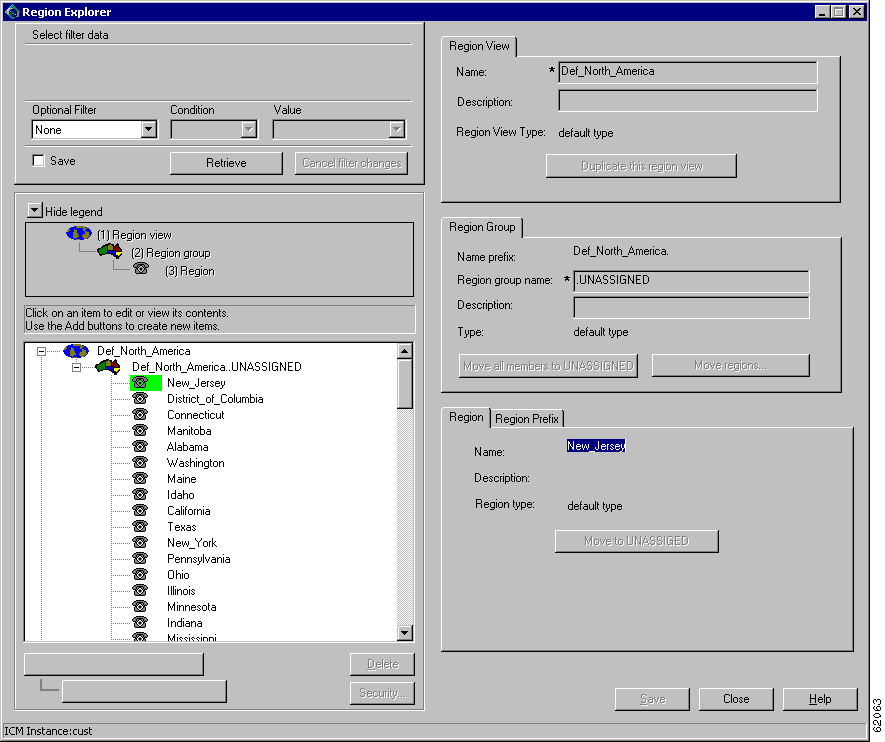
 |
Note To expand an element in the tree, click the plus sign (+) next to it. (The plus sign changes to a minus sign (-) when the branch is expanded.) To collapse the branch, click the minus sign. |
Each view consists of one or more group regions. Each group region contains zero, one, or more regions. You cannot modify the regions within the Region Explorer. You can define new group regions (defined as a set of regions) and move regions (defined as a set of prefixes) among group regions.
ICM software predefines a region for each U.S. state. In the following example, the NorthEast USA region contains six states.
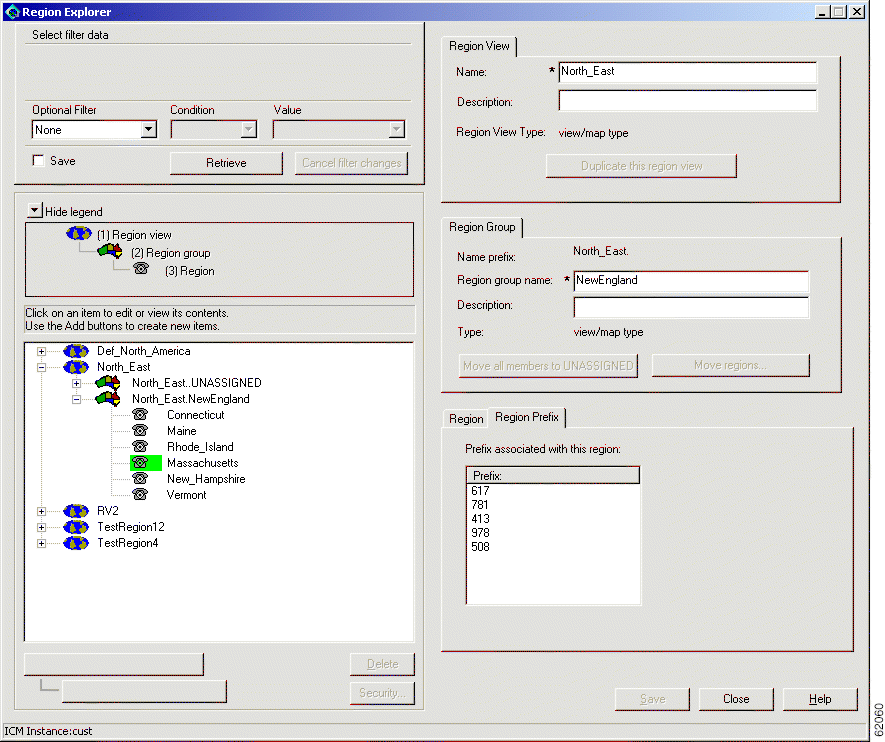
Each state contains one or more prefixes. For example, in Figure 2-7, Massachusetts contains five prefixes.
The Def_North_America view is predefined by ICM software. It contains only one parent region: UNASSIGNED. All of the U.S. states, Canadian provinces, and so on are members of this region. You can use this view as a template for creating new views.
You can right-click at any level of the Region Explorer's tree to see an associated options menu. These menus let you manipulate views and their associated regions.
You should be aware of the following when using the Region Explorer:
See the Region Explorer online help for procedures using this tool and for screen field and button descriptions.
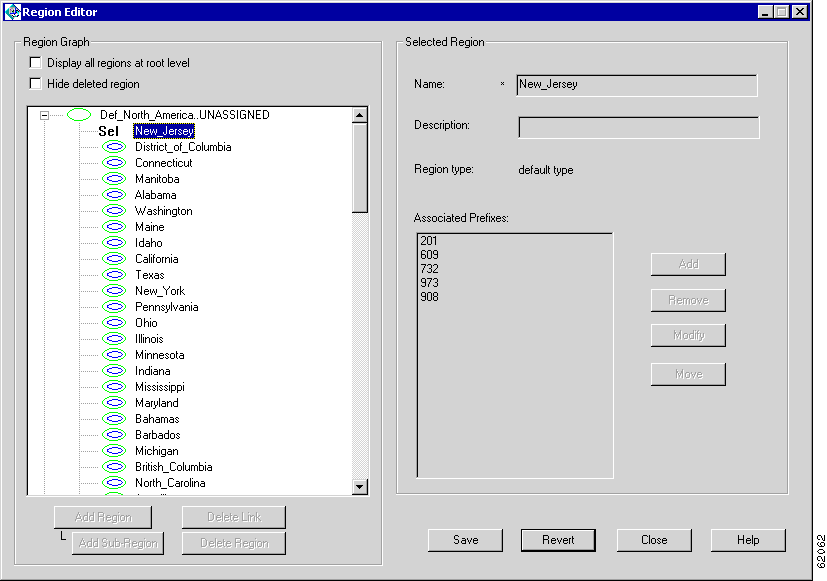
The left side of the Region Editor window contains a graphical list of regions which shows how individual regions are related to one another.
Step 2 Select a region in the graph to display its properties in the property tab on the right side of the window.
The Region Editor displays a tree graph to show the database collection of regions and their relationships. Table 2-1explains the meaning of the graph symbols.
| Symbol | Description |
|---|---|
| Parent regions are indicated by a box with a plus icon (if the tree is contracted) or a minus icon (if the tree is expanded). When a parent region is expanded, its sub-regions are displayed beneath it, as branches within the tree. |
| Sub-regions are indicated by the icon of an oval within an oval. |
| Shared sub-regions are indicated by an icon of intersecting ovals. |
 |
Note The Region Explorer displays a limited number of tree levels (region groups
and regions). In the Region Editor, the number of tree levels is not limited. That is why the add buttons are named Add Region (to the selected region) and Add sub-Region (to the selected region). |
The following two diagrams illustrate how the same data is both stored in the database and displayed in the Region Graph.
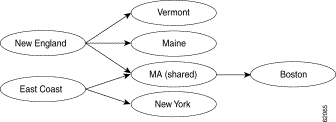
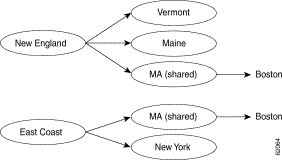
When you select a region in the Region Graph, its corresponding record is displayed in the Selected Region section of the Region Editor window. The buttons and edit fields are enabled and disabled based on the operations available for the given record.
Right clicking on a region in the Region Graph opens an options menu listing all that you can do with that region.
You can add, cut, copy, and paste one region or multiple regions at a time. You can also edit a custom region's data, including prefix entries.
Edits are not saved to the database until you click Save. By clicking Revert you can undo any changes you have made if you have not yet saved them.
See the Region Editor online help for procedures using this tool and for screen field and button descriptions.
For each call type, you must specify the scripts to execute for that call type and when each script should be enabled. Some scripts might be enabled at all times; others might be enabled only during certain hours of the day or certain days of the week, month, or year. You might even define a script to run only on a specific date during a specific period of time.
You can schedule a script to be enabled during a specific time period every day or only on certain days. You can specify days of the week, days of the month, days of the year, or specific dates on which the script becomes enabled. You can also specify days within each two week period.
To specify when each script is enabled, you set up a schedule for the call type through the Script Editor's Call Type Manager.
Step 2 To see the scripts scheduled for a call type, click the Schedules tab and select the Call Type from the drop-down list.
Step 3 Click the Add button. The Add Call Type Schedule dialog box appears.
Step 4 Optionally, select a Business Entity.
Step 5 Select a Script name.
Step 6 Select the Period tab and enter the following:
Step 7 Click the Description tab. The top of the dialog box contains text describing the Period tab. Check the text to be sure the schedule is set as you want.
Step 8 Optionally, add a comment in the Description field.
Step 9 When finished, click OK. (Changes you have made to the call type schedule do not take effect until you click OK in Call Type Manager.)
You can choose the granularity of the schedule by selecting from the left column of the Recurrence Pattern list. When you change this selection, the day specifications to the right of that section also change. Table 2-2 lists the recurrence pattern options and the days that you can specify for each.
| Pattern | Days | Comments |
|---|---|---|
Every day, every weekday, or every weekend day | Example: A script that is activated Monday through Friday every week. | |
Specific days of the week | Example: A script that is activated on Tuesday and Thursday every week. | |
Specific days of alternating weeks | In a biweekly pattern, the script is activated during the week following the start date you specify. Example: If you set up a script to run biweekly on Monday, it is activated on the first Monday that falls on or after the start date. Thereafter, it is activated on every-other Monday. | |
Specific days of the month | You can choose one of two options:
For more information, see "Defining Monthly Patterns" section. | |
Specific days of the year | This pattern is similar to Monthly, except that you can specify the month to which it applies. Example: A script that is active on the last Tuesday of October. For more information, see "Defining Yearly Patterns" section. | |
Specific starting and ending dates and times | When you choose this option, the Date Range and Time Range fields are disabled and any values you entered there are ignored. The script becomes active at the starting date and time you specify and remains active until the ending date and time you specify. |
You can choose to specify either an ordinal and day of the week or numeric day of the month. If you choose the first option, you can choose any ordinal and day of week value as shown in Table 2-3.
| Ordinal | Day of Week |
Every | Sunday |
For example, if many agents attend a regular meeting on the second Wednesday of each month, you might want to schedule different scripts to be active during that time.
If you want to specify that a script is active on specific days of a specific month (for example, the second Sunday in February), choose Yearly scheduling.
You can also use the Monthly option to specify a specific day of every month. If you choose the second radio item, you can specify the ordinal day of the month.

In this example, the script is active on the 12th of each month.
You can specify that a script runs on one or more specific days of the year. You can specify the days in either of two ways:
.
| Ordinal | Day | Month |
Every | Sunday | Every month |

If you want the script to be active on several specific dates of the year, you can enter a separate schedule entry for each date.
Only one script is enabled for a call type at any time. However, more than one script might be scheduled for a specific time period. For example, you might have a script scheduled to run between 8:00 AM and 5:00 PM every day and a second script scheduled to run between those same hours every December 25. When an overlap of this kind occurs, ICM software chooses the first of the overlapping scripts listed in the Call Type Manager's Schedule tab. For example, in the following case, the Christmas script would be used on December 25.
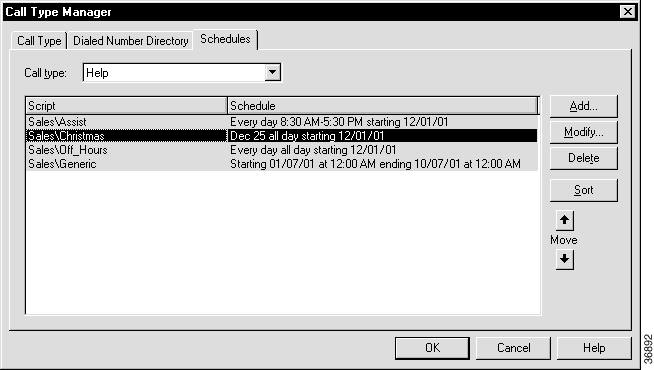
You can rearrange the order of the scripts by using the up and down arrow buttons. If you click the Sort button, ICM software arranges the scripts so that the most specific schedules appear first. Table 2-5 lists the types of schedules and the sorting priority ICM software gives to each.
| Priority | Schedule Recurrence |
1 | Range |
2 | Yearly |
3 | Monthly |
4 | Biweekly |
5 | Weekly |
6 | Daily |
To ensure that the script you want is enabled when you want it enabled, adjust the schedule accordingly.
![]()
![]()
![]()
![]()
![]()
![]()
![]()
![]()
Posted: Tue Jun 25 08:21:08 PDT 2002
All contents are Copyright © 1992--2002 Cisco Systems, Inc. All rights reserved.
Important Notices and Privacy Statement.